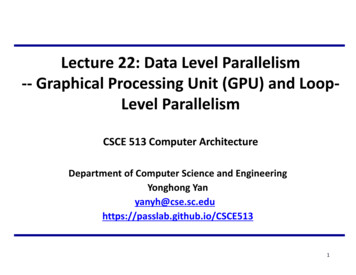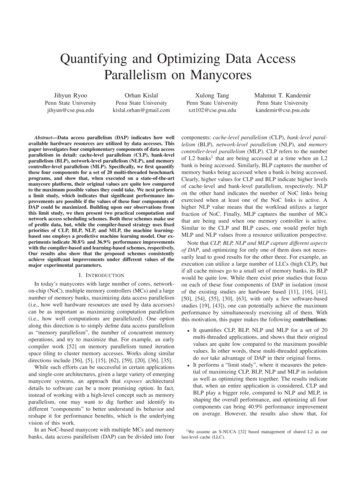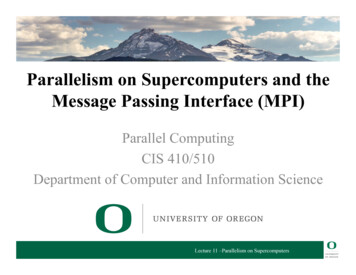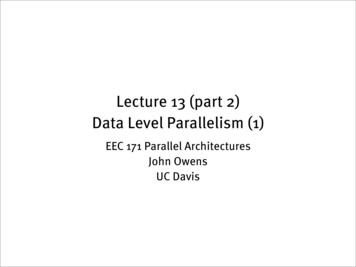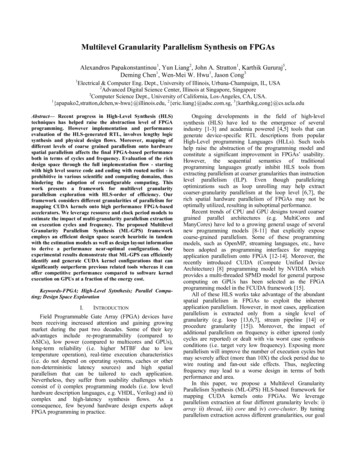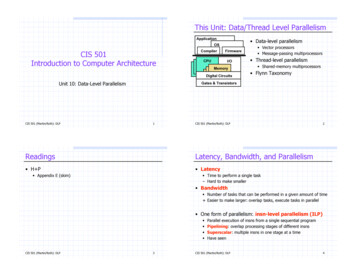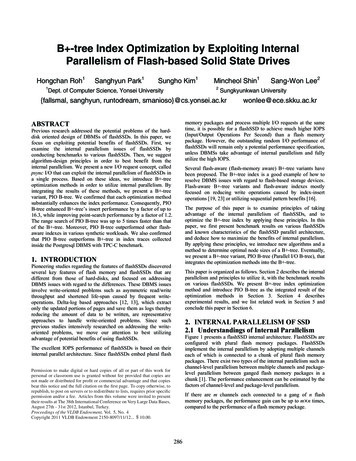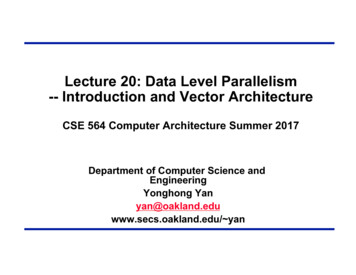
Transcription
Lecture 20: Data Level Parallelism-- Introduction and Vector ArchitectureCSE 564 Computer Architecture Summer 2017Department of Computer Science andEngineeringYonghong Yanyan@oakland.eduwww.secs.oakland.edu/ yan
Very Important Terms§ Dynamic Scheduling à Out-of-order Execution§ Speculation à In-order Commit§ Superscalar à Multiple onStations, Load/StoreBuffer and CDBData hazards(RAW, ranch Prediction(BHT/BTB) andReorder BufferControlhazards(branch, oftware andHardwareTo IncreaseCPIBy compileror hardwareSuperscalar/ MultipleVLIWissue2
Time (processor cycle)Last Lecture: MultithreadingSuperscalarFine-Grained Coarse-GrainedThread 1Thread 2MultiprocessingThread 3Thread 4SimultaneousMultithreadingThread 5Idle slot3
CSE 564 Class Contents§§Introduction to Computer Architecture (CA)Quantitative Analysis, Trend and Performance of CA– Chapter 1§Instruction Set Principles and Examples– Appendix A§Pipelining and Implementation, RISC-V ISA and Implementation– Appendix C, RISC-V (riscv.org) and UCB RISC-V impl§Memory System (Technology, Cache Organization and Optimization,Virtual Memory)– Appendix B and Chapter 2– Midterm covered till Memory Tech and Cache Organization§Instruction Level Parallelism (Dynamic Scheduling, Branch Prediction,Hardware Speculation, Superscalar, VLIW and SMT)– Chapter 3§ Data Level Parallelism (Vector, SIMD, and GPU)– Chapter 4§ Thread Level Parallelism– Chapter 54
Topics for Data Level Parallelism (DLP)§ Parallelism (centered around )– Instruction Level Parallelism– Data Level Parallelism– Thread Level Parallelism§ DLP Introduction and Vector Architecture– 4.1, 4.2§ SIMD Instruction Set Extensions for Multimedia– 4.3§ Graphical Processing Units (GPU)– 4.4§ GPU and Loop-Level Parallelism and Others– 4.4, 4.5, 4.6, 4.7Finish in two/three sessions5
Acknowledge and Copyright§ Slides adapted from– UC Berkeley course “Computer Science 252: GraduateComputer Architecture” of David E. Culler Copyright(C) 2005UCB– UC Berkeley course Computer Science 252, GraduateComputer Architecture Spring 2012 of John KubiatowiczCopyright(C) 2012 UCB– Computer Science 152: Computer Architecture andEngineering, Spring 2016 by Dr. George Michelogiannakisfrom UC Berkeley– Arvind (MIT), Krste Asanovic (MIT/UCB), Joel Emer (Intel/MIT),James Hoe (CMU), John Kubiatowicz (UCB), and DavidPatterson (UCB)§ 6
Flynn’s Classification (1966)Broad classification of parallel computing systems– based upon the number of concurrent Instruction(or control) streams and Data streamsMichael J. Flynn:§ SISD: Single Instruction, Single Datahttp://arith.stanford.edu/ flynn/– conventional uniprocessor§ SIMD: Single Instruction, Multiple Data– one instruction stream, multiple data paths– distributed memory SIMD (MPP, DAP, CM-1&2, Maspar)– shared memory SIMD (STARAN, vector computers)§ MIMD: Multiple Instruction, Multiple Data– message passing machines (Transputers, nCube, CM-5)– non-cache-coherent shared memory machines (BBN Butterfly, T3D)– cache-coherent shared memory machines (Sequent, Sun Starfire,SGI Origin)§ MISD: Multiple Instruction, Single Data– Not a practical configuration7
Flynn’s Taxonomyhttps://en.wikipedia.org/wiki/Flynn%27s taxonomy8
More Categories§ Single program, multiple data (SPMD)– Multiple autonomous processors execute the program atindependent points– Difference with SIMD: SIMD imposes a lockstep– Programs at SPMD can be at independent points– SPMD can run on general purpose processors– Most common method for parallel computing§ Multiple program,multiple data (MPMD) MIMD– Multiple autonomousprocessorssimultaneouslyoperating at least 2independent programs9
SIMD: Single Instruction, Multiple Data(Data Level Paralleism)§ SIMD architectures can exploitsignificant data-level parallelism for:– matrix-oriented scientific computing– media-oriented image and sound processors§ SIMD is more energy efficient than MIMD– Only needs to fetch one instruction per data operationprocessing multiple data elements– Makes SIMD attractive for personal mobile devices§ SIMD allows programmer to continue to thinksequentiallyInstructions streamDataDataDataDataControl unitprocessor processor processor processor10
SIMD Parallelism§ Three variations– Vector architectures– SIMD extensions– Graphics Processor Units (GPUs)§ For x86 processors:– Expect two additional cores per chip per year (MIMD)– SIMD width to double every four years– Potential speedup from SIMD to be twice that from MIMD!Vector Architecture11
VLIW vs Vector§ VLIW takes advantage of instruc5on level parallelism(ILP) by specifying mul5ple instruc5ons to execute inparallelInt Op 1Int Op 2Mem Op 1Mem Op 2FP Op 1FP Op 2§ Vector architectures perform the same opera5on onmul5ple data elements – single instruc5on– Data-level parallelismVector ArithmeticInstructionsADDV v3, v1, v2v1v2 v3 [0] [1] [VLR-1]12
Vector Programming ModelScalar Registersr15v15r0v0Vector Registers[0] [1] [2]Vector Length RegisterVector ArithmeticInstructionsADDV v3, v1, v2v1v2 v3Vector Load andStore InstructionsLV v1, (r1, r2)Base, r1[VLRMAX-1]VLRStride in r2 [0] [1]v1 [VLR-1]Vector RegisterMemory13
Control Information§ VLR limits the highest vector element to be processedby a vector instruction– VLR is loaded prior to executing the vector instruction with aspecial instruction§ Stride for load/stores:– Vectors may not be adjacent in memory addresses– E.g., different dimensions of a matrix– Stride can be specified as part of the load/storeVector Load andStore InstructionsLV v1, (r1, r2)Base, r1Stride in r2v1Vector RegisterMemory14
Basic Structure of Vector Architecuture§ VMIPS§ eight 64-element vectorregisters§ all the functional units arevector functional units.§ The vector and scalarregisters have a significantnumber of read and writeports to allow multiplesimultaneous vectoroperations.§ A set of crossbar switches(thick gray lines) connectsthese ports to the inputsand outputs of the vectorfunctional units.15
VMIPS Vector Instructions§ Suffix– VV suffix– VS suffix§ Load/Store– LV/SV– LVWS/SVWS§ Registers– VLR (vectorlengthregister)– VM (vectormask)16
Highlight of VMIPS Vector Instructions§Vector operations have the letters “VV/VS” appended.– E.g. ADDVV.D is an addition of two double-precision vectors.§Vector instructions input:– 1) a pair of vector registers (ADDVV.D) or– 2) a vector register and a scalar register (ADDVS.D).» all operations use the same value in the scalar register as one input.§LV/LVWS and SV/SVWS: vector load and vector store which load or storean entire vector of double-precision data.––––§One operand is the vector register to be loaded or stored;The other operand, a GPR, is the starting address of the vector in memory.LVWS/SVWS: For stride load/storeLVI/SVI: indexed load/storeTwo additional special-purpose registers:– Vector-length register: when the natural vector length is NOT 64– Vector-mask register: when loops involve IF statements.§In-order scalar processor for vector architecture– Not out- of-order superscalar processors.§Vectors naturally accommodate varying data sizes.– one view of a vector register size is 64 64-bit data elements, but 128 32-bit elements, 25616-bit elements, and even 512 8-bit elements are equally valid views.17
AXPY (64 elements) (Y a * X Y) in MIPSand VMIPSfor (i 0; i 64; i )The starting addresses of X and YY[i] a* X[i] Y[i]; are in Rx and Ry, respectively§ # instrs:– 6 vs 600§ Pipeline stalls– 64x higher byMIPS§ Vector chaining(forwarding)– V1, V2, V3 and V418
Vector Memory-Memory versus VectorRegister Machines§ Vector memory-memory instructions hold all vectoroperands in main memory§ The first vector machines, CDC Star-100 (‘73) and TIASC (‘71), were memory-memory machines§ Cray-1 (’76) was first vector register machineVector Memory-Memory CodeExample Source Codefor (i 0; i N; i ){C[i] A[i] B[i];D[i] A[i] - B[i];}ADDV C, A, BSUBV D, A, BVector Register CodeLV V1, ALV V2, BADDV V3, V1, V2SV V3, CSUBV V4, V1, V2SV V4, D19
Vector Memory-Memory vs. VectorRegister Machines§ Vector memory-memory architectures (VMMA) requiregreater main memory bandwidth, why?– All operands must be read in and out of memory§ VMMAs make if difficult to overlap execution ofmultiple vector operations, why?– Must check dependencies on memory addresses§ VMMAs incur greater startup latency– Scalar code was faster on CDC Star-100 (VMM) for vectors 100 elements§ Apart from CDC follow-ons (Cyber-205, ETA-10) allmajor vector machines since Cray-1 have had vectorregister architectures§ (we ignore vector memory-memory from now on)20
Vector Instruction Set Advantages§ Compact– one short instruction encodes N operations§ Expressive and predictable, tells hardwarethat these N operations:–––––are independentuse the same functional unitaccess disjoint registersaccess registers in same pattern as previous instructionsaccess a contiguous block of memory(unit-stride load/store)– access memory in a known pattern(strided load/store)§ Scalable– can run same code on more parallel pipelines (lanes)21
History: Supercomputers§ Definition of a supercomputer:The Father of Supercomputing– Fastest machine in world at giventask– A device to turn a compute-boundproblem into an I/O bound problem– Any machine costing 30M – Any machine designed bySeymour Cray (originally)§ CDC6600 (Cray, 1964) regarded asfirst supercomputer– A vector machine§ www.cray.com: TheSupercomputer Companyhttps://en.wikipedia.org/wiki/Seymour ay22
Supercomputer Applications§ Typical application areas–––––––Military research (nuclear weapons, cryptography)Scientific researchWeather forecastingOil explorationIndustrial design (car crash simulation)BioinformaticsCryptography§ All involve huge computations on large data sets§ In 70s-80s, Supercomputer Vector Machine23
Vector Supercomputers§ Epitomy: Cray-1, 1976§ Scalar Unit– Load/Store Architecture§ Vector Extension– Vector Registers– Vector Instructions§ Implementation–––––Hardwired ControlHighly Pipelined Functional UnitsInterleaved Memory SystemNo Data CachesNo Virtual Memory24
Cray-1 (1976)64 ElementVector RegistersSingle PortMemory16 banks of 64bit words 8-bit SECDED( (Ah) j k m )(A0)80MW/sec dataload/storeTjk( (Ah) j k m )(A0)320MW/secinstructionbuffer refill64T RegsSi64B x164 Instruction Buffersmemory bank cycle 50 nsV0V1V2V3V4V5V6V7ViV. MaskVjV. LengthVkFP AddSjFP MulSkFP RecipSiInt AddInt LogicInt ShiftPop CntAjAkAiAddr AddAddr MulCIPLIPprocessor cycle 12.5 ns (80MHz)25
Today’s Supercomputers (www.top500.org)§ MIMD and HybridMIMD/vector orMIMD/GPU26
#1 of TOP500 as of Nov 2016http://sc16.supercomputing.org/27
Vector Arithmetic Execution Use deep pipeline ( fast clock)to execute element opera5ons Simplifies control of deep pipelinebecause elements in vector areindependent ( no hazards!)V V V1 2 3Six stage mul-ply pipelineV3 - v1 * v228
Vector Execution: Element Group29
Vector Instruction Execution withPipelined Functional UnitsADDV C,A,BExecution usingone pipelinedfunctional unitExecution usingfour pipelinedfunctional unitsA[6]B[6]A[24] B[24] A[25] B[25] A[26] B[26] A[27] B[27]A[5]B[5]A[20] B[20] A[21] B[21] A[22] B[22] A[23] B[23]A[4]B[4]A[16] B[16] A[17] B[17] A[18] B[18] A[19] B[19]A[3]B[3]A[12] B[12] A[13] B[13] A[14] B[14] A[15] ]C[0]C[1]C[2]C[3]30
Vector Unit Structure (4 Lanes)Func-onal UnitVectorRegistersElements0, 4, 8, Elements1, 5, 9, Elements2, 6, 10, Elements3, 7, 11, LaneMemory Subsystem31
Vector Instruction Parallelism§ Can overlap execution of multiple vector instructions– example machine has 32 elements per vector register and 8lanesLoad UnitloadMultiply UnitAdd UnitmuladdtimeloadmuladdInstructionissueComplete 24 opera5ons/cycle while issuing 1 short instruc5on/cycle32
Vector ChainingVector version of register bypassing– introduced with Cray-1LVV1v1V2V3V4V5MULV v3,v1,v2ADDV v5, v3, v4ChainLoadUnitMult.ChainAddMemory33
Vector Chaining Advantage Without chaining, must wait for last element of result to bewriaen before star5ng dependent instruc5onLoadTimeMulAdd With chaining, can start dependent instruc5on as soon as firstresult appearsLoadMulAdd34
Automatic Code Vectorizationfor (i 0; i N; i )C[i] A[i] B[i];Vectorized CodeScalar Sequen-al CodeloadloadIter. 1addstoreloadloadIter. 2addstoreTimeloadloadloadloadaddaddstorestoreIter. 1Iter. 2Vector Instruc-onVectoriza5on is a massive compile-5mereordering of opera5on sequencing requires extensive loop dependence analysis35
Vector Length Register§ Vector length not known at compile time?§ Use Vector Length Register (VLR)§ Use strip mining for vectors over the maximum length(serialized version before vectorization by compiler)low 0;VL (n % MVL); /*find odd-size piece using modulo op % */for (j 0; j (n/MVL); j j 1) { /*outer loop*/for (i low; i (low VL); i i 1) /*runs for length VL*/Y[i] a * X[i] Y[i] ; /*main operation*/low low VL; /*start of next vector*/VL MVL; /*reset the length to maximum vector length*/}36
Vector StripminingProblem: Vector registers have finite lengthSolution: Break loops into pieces that fit in registers,“Stripmining”ANDI R1, N, 63# N mod 64MTC1 VLR, R1# Do remainderfor (i 0; i N; i )loop:C[i] A[i] B[i];LV V1, RADSLL R2, R1, 3# Multiply by 8A BCDADDU RA, RA, R2 # Bump pointerRemainder LV V2, RBDADDU RB, RB, R2ADDV.D V3, V1, V264 elements SV V3, RCDADDU RC, RC, R2DSUBU N, N, R1 # Subtract elementsLI R1, 64 MTC1 VLR, R1# Reset full lengthBGTZ N, loop# Any more to do?37
Vector Mask Registersfor (i 0; i 64; i i 1)if (X[i] ! 0)X[i] X[i] – Y[i];§ Use vector mask register to “disable” elements (1 bitper F0V1,V1,V2Rx,V1;load vector X into V1;load vector Y;load FP zero into F0;sets VM(i) to 1 if V1(i)! F0;subtract under vector mask;store the result in X§ GFLOPS rate decreases!– Vector operation becomes bubble (“NOP”) at elements wheremask bit is clear38
Masked Vector InstructionsSimple Implementa5onDensity-Time Implementa5on– execute all N opera5ons, turn off resultwriteback according to mask– scan mask vector and only executeelements with non-zero masksM[7] 1 X[7]Y[7]M[7] 1M[6] 0 X[6]Y[6]M[6] 0M[5] 1 X[5]Y[5]M[5] 1M[4] 1 X[4]Y[4]M[4] 1M[3] 0 X[3]Y[3]M[3] 0X[5]M[2] 0X[4]M[2] 0X[2]M[1] 1X[1]X[7]Y[7]M[1] 1M[0] 0X[1]Write data portM[0] 0X[0]Write Enable Write data port39
Compress/Expand Operations§ Compress packs non-masked elements from onevector register contiguously at start of destinationvector register– population count of mask vector gives packed vector length§ Expand performs inverse operationM[7] 1M[6] 0M[5] 1M[4] 1M[3] 0M[2] 0M[1] 1M[0] ]B[0]M[7] 1M[6] 0M[5] 1M[4] 1M[3] 0M[2] 0M[1] 1M[0] 0ExpandUsed for density-time conditionals and also for generalselection operations40
StrideDGEMM (Double-Precision Matrix Multiplication)for (i 0; i 100; i i 1)for (j 0; j 100; j j 1) {A[i][j] 0.0;for (k 0; k 100; k k 1)A[i][j] A[i][j] B[i][k] * D[k][j];}§ Must vectorize multiplication of rows of B with columns of D– Row-major: B: 1 double (8 bytes), and D: 100 doubles (800 bytes)§ Use non-unit stride– LDWS§ Bank conflict (stall) occurs when the same bank is hit faster thanbank busy time:– #banks / LCM(stride,#banks) bank busy time41
Scatter-Gather§ Sparse matrix:– Non-zero values are compacted to a smaller value array (A[ ])– indirect array indexing, i.e. use an array to store the index tovalue array (K[ ])for (i 0; i n; i i 1)A[K[i]] A[K[i]] C[M[i]];§ Use index vector:LVVk, RkLVIVa, (Ra Vk)LVVm, RmLVIVc, (Rc Vm)ADDVV.D Va, Va, VcSVI(Ra Vk), Va;load K;load A[K[]];load M;load C[M[]];add them;store A[K[]]42
Memory operations§ Load/store operations move groups of data betweenregisters and memory– Increased mem/instr ratio (intensity)§ Three types of addressing– Unit stride» Contiguous block of information in memory» Fastest: always possible to optimize this– Non-unit (constant) stride» Harder to optimize memory system for all possible strides» Prime number of data banks makes it easier to support differentstrides at full bandwidth– Indexed (gather-scatter)» Vector equivalent of register indirect» Good for sparse arrays of data» Increases number of programs that vectorize43
Interleaved Memory Layout§ Great for unit stride:– Contiguous elements in different DRAMs– Startup time for vector operation is latency of single read§ What about non-unit stride?– Above good for strides that are relatively prime to 8– Bad for: 2, 4Vector ProcessorUnpipelinedDRAMAddrAddrAddrMod 8 Mod 8 Mod 8 2 3 4UnpipelinedDRAMAddrMod 8 pelinedDRAMUnpipelinedDRAMUnpipelinedDRAMAddrMod 8 0AddrMod 8 5AddrAddrMod 8 Mod 8 7 644
Avoiding Bank Conflicts§ Lots of banksint x[256][512];for (j 0; j 512; j j 1)for (i 0; i 256; i i 1)x[i][j] 2 * x[i][j];§ Even with 128 banks, since 512 is multiple of 128,conflict on word accesses§ SW: loop interchange or declaring array not power of2 (“array padding”)§ HW: Prime number of banks–––––bank number address mod number of banksaddress within bank address / number of words in bankmodulo & divide per memory access with prime no. banks?address within bank address mod number words in bankbank number? easy if 2N words per bank45
Finding Bank Number and Address withina bank§Problem: Determine the number of banks, Nb and the number of wordsin each bank, Nw, such that:– given address x, it is easy to find the bank where x will befound, B(x), and the address of x within the bank, A(x).– for any address x, B(x) and A(x) are unique– the number of bank conflicts is minimized§Solution: Use the Chinese remainder theorem to determine B(x) andA(x):B(x) x MOD NbA(x) x MOD Nw where Nb and Nw are co-prime (no factors)– Chinese Remainder Theorem shows that B(x) and A(x)unique.§§Condition allows Nw to be power of two (typical) if Nb is prime of form2m-1.Simple (fast) circuit to compute (x mod Nb) when Nb 2m-1:––––Since 2k 2k-m (2m-1) 2k-m 2k MOD Nb 2k-m MOD Nb 2j with j mAnd, remember that: (A B) MOD C [(A MOD C) (B MOD C)] MOD Cfor every power of 2, compute single bit MOD (in advance)B(x) sum of these values MOD Nb(low complexity circuit, adder with m bits)46
Conclusion§ Vector is alternative model for exploiting ILP– If code is vectorizable, then simpler hardware, more energyefficient, and better real-time model than Out-of-ordermachines– Design issues include number of lanes, number of functionalunits, number of vector registers, length of vector registers,exception handling, conditional operations47
- Instruction Level Parallelism - Data Level Parallelism - Thread Level Parallelism § DLP Introduction and Vector Architecture - 4.1, 4.2 § SIMD Instruction Set Extensions for Multimedia - 4.3 § Graphical Processing Units (GPU) - 4.4 § GPU and Loop-Level Parallelism and Others - 4.4, 4.5, 4.6, 4.7
